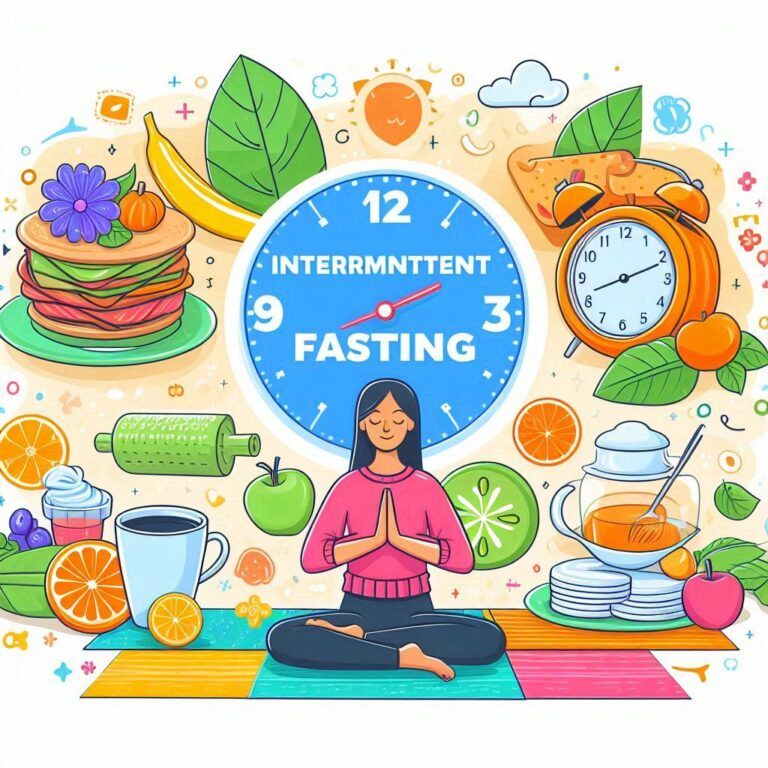How Intermittent Fasting Can Fuel Muscle Gain
Intermittent fasting (IF) is gaining popularity among health enthusiasts worldwide. It’s commonly hailed as a weight-loss wonder, but here’s a twist: evidence is mounting that IF could be just as beneficial for those looking to bulk up their muscle mass. Intermittent fasting is stepping into the spotlight as a potent muscle-building ally.
This isn’t just about shedding pounds—it’s also about paving a path for muscle gain. Intermittent fasting does more than defy the old ‘eat-big-to-get-big’ adage; it leverages the body’s hormonal chemicals to support muscle development. By understanding the mechanisms behind intermittent fasting, you’ll discover its multifaceted role in enhancing body composition.
So, let’s set the stage with an overview. During fasting, your body goes through a series of changes that create an ideal environment for muscle growth. These survival mechanisms that once helped our ancestors thrive during food scarcity. In the next section, I’ll discuss growth hormones and insulin management, and you’ll learn more about synchronizing your fasting schedule with your training routine.
Physiological Advantages of Fasting for Muscle Development
Intermittent fasting (IF) isn’t just about shedding pounds; it also packs a powerful punch for building muscle. That’s right—the same eating pattern that garnered fame for weight loss is also stacked with benefits supporting muscle growth. Let’s look at the physiological changes that unfold in your body during fasting and how they propel muscle development.
During fasting, your body undergoes a significant surge in growth hormone production. Think of growth hormone as your muscle-building ally; it’s crucial for muscle development, enhancing the repair and growth of muscle tissues. This uptick in growth hormone levels plays a starring role in improving both muscle mass and strength.
But the advantages continue beyond there. Intermittent fasting also sharpens insulin sensitivity. This means your body gets better at using this critical hormone, which helps you direct those precious nutrients right where they’re needed – into muscle cells and away from fat stores. The result? You’re setting the stage for not just muscle growth but robust post-exercise recovery as well.

Protein synthesis is the body’s method of repairing and building muscle tissues, another area where intermittent fasting shows its might. Eating protein-rich meals in your designated window, particularly after workouts, aligns those critical amino acids with the body’s peak rebuilding times.
This intentional timing can significantly maximize muscle protein synthesis, pushing your muscle gains to new heights.
Optimizing Workouts and Nutrition with Intermittent Fasting
You’ll learn that intermittent fasting isn’t just about changing when you eat; it’s also about enhancing your ability to work out effectively. Fasting periods can trigger a rise in catecholamines—adrenaline and noradrenaline. This adrenaline rush isn’t just a feeling; it can translate to increased energy, focus, and even a higher pain threshold during workouts.
Now, nutrient efficiency is a big game-changer for muscle gain. It’s all about ensuring each calorie and nutrient you consume is used to its full potential, primarily to fuel muscle recovery and growth. When you break your fast, your body is like a sponge—ready and eager to soak up nutrients. Post-fast dietary choices can lead to better muscle recovery and support growth.
Don’t worry too much about making things complicated. Observe how your body responds, and then consider a simple strategy: consume a protein and carb-rich meal after your resistance training. That way, your body’s heightened nutrient absorption works to your benefit, shuttling those proteins and carbs to your muscles where they’re needed most.
So, how do you leverage this for your training?
Think about timing your workouts just before your eating window. This allows you to hit the gym when your catecholamine levels are high and follow up with a nutrient-packed meal to capitalize on your body’s primed state for muscle repair and growth.
Best Practices for Building Muscle with Intermittent Fasting
Intermittent fasting isn’t just about timing your meals; it’s also about syncing your body’s natural rhythms with your fitness goals. To harness the power of IF for muscle gain, you must integrate it with a consistent Strength Training Program. Strength training, like weight lifting, triggers signals in your body to build muscle and get stronger. And when you pair this with intermittent fasting, you’re setting the stage for more effective gains.
Hydration is key. Although you might be limiting your food intake for specific hours, always focus on water. Staying well-hydrated is vital for your health and can significantly influence your workout performance and recovery. Plus, it ensures all the nutrient-rich blood gets to those hard-worked muscles.
You must tune in to your body. Intermittent fasting is not a one-size-fits-all solution. Pay attention to how you feel before, during, and after workouts and your energy levels throughout fasting. If you’re feeling worn down or your gym performance starts to wane, it may be a sign to adjust your fasting schedule or your meal composition.
Lastly, keep going even if your progress doesn’t skyrocket immediately. Building muscle is a journey; Be patient and give your body time to adapt. With diligence and fine-tuning, combining intermittent fasting with resistance training can lead to impressive muscle growth and a body you can be proud of.
If you found this blog helpful, read Myths and Facts About Intermittent Fasting.
Engage with Me!
Ask Questions: If you have questions about intermittent fasting and muscle gain, please comment below. Thank you!








I’m delighted I came across this article because I’ve heard such good things about IF. I did it a long time ago when brown rice fasts were fashionable. Lately, I’ve been trying to develop muscles because I’m an alpine climber, and I need to increase my strength for a huge climb I’m doing in Pokhara, Nepal, next spring.
I understand hormones and insulin and the consequent muscle repair, etc. Your article really explains this so clearly. But my question is, if I enter this kind of regime, will my muscles—especially my upper body—get overly bulky? Sometimes, on challenging cliff climbs, we need to squeeze through narrow spaces, and I’m worried that if my muscles grow, as your excellent illustrations indicate, I might get stuck! HELP!!!
I need some reassurance about this before I proceed. Can I reach you to discuss it?
Hello, Linden,
I’m glad to hear you found the article helpful!
It’s great to know you’re gearing up for such an exciting climb in Pokhara. Your concern about gaining excessive muscle bulk is understandable, especially given the unique demands of alpine climbing.
The answer to your question. So many factors come into play with that, like strength training. Intermittent fasting (IF) combined with strength training can help you build muscle, but it’s important to note that excessively bulky usually requires a particular type of training and diet regimen. For alpine climbing, your training would likely focus on functional strength and endurance rather than just hypertrophy (muscle growth).
Here are a few points to reassure you:
Training Focus: Tailor your workouts to emphasize functional strength and muscular endurance. Incorporate compound movements and bodyweight exercises that simulate climbing motions.
Nutrition Balance: Ensure your diet supports muscle repair and energy needs without excessive calorie surplus that promotes bulk. Adequate protein intake is crucial but doesn’t necessarily lead to bulkiness.
Genetic Factors: Everyone’s body responds differently to training. Significant muscle hypertrophy requires consistent, targeted effort over a long period, so you’ll unlikely bulk up excessively without intending to.
Flexibility and Mobility: Incorporate flexibility and mobility training into your routine to maintain the agility needed for tight squeezes and complex maneuvers on the cliffs.
Feel free to Contact Me with more questions or need advice. I’d be happy to discuss your training further and help ensure you’re on the right track for your upcoming climb!
All the best,
Michael